Implementation of Transition Metal Phosphides as Pt-Free Catalysts for PEM Water Electrolysis
Abstract
:1. Introduction
2. Materials and Methods
2.1. Catalysts Preparation
2.2. Materials Characterization
2.3. Electrocatalytic Tests
2.3.1. Ex Situ Tests
2.3.2. In Situ Tests
3. Results and Discussion
3.1. Catalyst’s Characterization
3.1.1. N2 Adsorption–Desorption Equilibrium Isotherms at −196 °C
3.1.2. Thermogravimetric Analysis
3.1.3. X-ray Diffraction
3.2. Electrochemical Analysis
3.2.1. Ex Situ CV and EIS
3.2.2. In Situ Polarization Curves and EIS
4. Conclusions
Author Contributions
Funding

Institutional Review Board Statement
Informed Consent Statement
Conflicts of Interest
References
- Kumar, S.S.; Himabindu, V. Hydrogen production by PEM water electrolysis—A review. Mater. Sci. Energy Technol. 2019, 2, 442–454. [Google Scholar] [CrossRef]
- Electricity. Our World in Data. 2021. Available online: https://ourworldindata.org/electricity-mix (accessed on 14 June 2021).
- BP Statistical Review of World Energy 2018. Available online: https://www.bp.com/content/dam/bp/business-sites/en/global/corporate/pdfs/energy-economics/statistical-review/bp-stats-review-2018-full-report.pdf (accessed on 14 June 2021).
- Nikolaidis, P.; Poullikkas, A. A comparative overview of hydrogen production processes. Renew. Sustain. Energy Rev. 2017, 67, 597–611. [Google Scholar] [CrossRef]
- Callejas, J.F.; Read, C.G.; Roske, C.W.; Lewis, N.S.; Schaak, R.E. Synthesis, Characterization, and Properties of Metal Phosphide Catalysts for the Hydrogen-Evolution Reaction. Chem. Mater. 2016, 28, 6017–6044. [Google Scholar] [CrossRef]
- Dou, Y.; Sun, L.; Ren, J.; Dong, L. Opportunities and future challenges in hydrogen economy for sustainable development. In Hydrogen Economy: Supply Chain, Life Cycle Analysis and Energy Transition for Sustainability; Elsevier: Amsterdam, The Netherlands, 2017; pp. 277–305. [Google Scholar]
- Contaldi, M.; Gracceva, F.; Mattucci, A. Hydrogen perspectives in Italy: Analysis of possible deployment scenarios. Int. J. Hydrogen Energy 2008, 33, 1630–1642. [Google Scholar] [CrossRef]
- Abbasi, T.; Abbasi, S. ‘Renewable’ hydrogen: Prospects and challenges. Renew. Sustain. Energy Rev. 2011, 15, 3034–3040. [Google Scholar] [CrossRef]
- States, M. What is CertifHy: CertifHy Aims to Develop the 1st European-Wide Green and Low Carbon Hydrogen GO Scheme One Definition of Green and Low Carbon Hydrogen throughout Europe Gives Confidence to Consumers and Will Allow Green H2 Uptake: A Common Agreement. 2018, pp. 1–17. Available online: https://www.fch.europa.eu/sites/default/files/CertifHy_AWP2018_Compliance_verification_V1.pdf (accessed on 20 February 2022).
- Ursua, A.; Gandia, L.M.; Sanchis, P. Hydrogen Production from Water Electrolysis: Current Status and Future Trends. Proc. IEEE 2012, 100, 410–426. [Google Scholar] [CrossRef]
- Xu, W.; Scott, K. The effects of ionomer content on PEM water electrolyser membrane electrode assembly performance. Int. J. Hydrogen Energy 2010, 35, 12029–12037. [Google Scholar] [CrossRef]
- Sun, H.; Liu, H.; Nie, M.; Zhao, Z.; Xue, Z.; Liao, J.; Xue, F.; Zhang, S.; Wu, M.; Gao, T. Synthesis and hydrogen evolution reaction of nanosized Ag–ZnO coated MoS2. Ceram. Int. 2021, 47, 13994–14000. [Google Scholar] [CrossRef]
- Hughes, J.P.; Clipsham, J.; Chavushoglu, H.; Rowley-Neale, S.J.; Banks, C.E. Polymer electrolyte electrolysis: A review of the activity and stability of non-precious metal hydrogen evolution reaction and oxygen evolution reaction catalysts. Renew. Sustain. Energy Rev. 2021, 139, 110709. [Google Scholar] [CrossRef]
- Zhang, S.; Zhang, X.; Rui, Y.; Wang, R.; Li, X. Recent advances in non-precious metal electrocatalysts for pH-universal hydrogen evolution reaction. Green Energy Environ. 2020, 6, 458–478. [Google Scholar] [CrossRef]
- Wang, Y.; Yan, D.; El Hankari, S.; Zou, Y.; Wang, S. Recent Progress on Layered Double Hydroxides and Their Derivatives for Electrocatalytic Water Splitting. Adv. Sci. 2018, 5, 1800064. [Google Scholar] [CrossRef] [PubMed]
- Li, Y.; Li, R.; Wang, D.; Xu, H.; Meng, F.; Dong, D.; Jiang, J.; Zhang, J.; An, M.; Yang, P. A review: Target-oriented transition metal phosphide design and synthesis for water splitting. Int. J. Hydrogen Energy 2020, 46, 5131–5149. [Google Scholar] [CrossRef]
- Abbas, M.A.; Bang, J.H. Rising Again: Opportunities and Challenges for Platinum-Free Electrocatalysts. Chem. Mater. 2015, 27, 7218–7235. [Google Scholar] [CrossRef]
- Yan, Y.; Shi, X.; Miao, M.; He, T.; Dong, Z.H.; Zhan, K.; Yang, J.H.; Zhao, B.; Xia, B.Y. Bio-inspired design of hierarchical FeP nanostructure arrays for the hydrogen evolution reaction. Nano Res. 2017, 11, 3537–3547. [Google Scholar] [CrossRef]
- Yang, X.; Lu, A.-Y.; Zhu, Y.; Min, S.; Hedhili, M.N.; Han, Y.; Huang, K.-W.; Li, L.-J. Rugae-like FeP nanocrystal assembly on a carbon cloth: An exceptionally efficient and stable cathode for hydrogen evolution. Nanoscale 2015, 7, 10974–10981. [Google Scholar] [CrossRef] [PubMed] [Green Version]
- Yang, J.; Zhang, Y.; Sun, C.; Liu, H.; Li, L.; Si, W.; Huang, W.; Yan, Q.; Dong, X. Graphene and cobalt phosphide nanowire composite as an anode material for high performance lithium-ion batteries. Nano Res. 2016, 9, 612–621. [Google Scholar] [CrossRef]
- Wang, X.; Kolen’Ko, Y.V.; Bao, X.-Q.; Kovnir, K.; Liu, L. One-Step Synthesis of Self-Supported Nickel Phosphide Nanosheet Array Cathodes for Efficient Electrocatalytic Hydrogen Generation. Angew. Chem. Int. Ed. 2015, 54, 8188–8192. [Google Scholar] [CrossRef] [PubMed]
- Miles, M.H.; Thomason, M.A. Periodic Variations of Overvoltages for Water Electrolysis in Acid Solutions from Cyclic Voltammetric Studies. J. Electrochem. Soc. 1976, 123, 1459–1461. [Google Scholar] [CrossRef]
- Platinum Price. Available online: http://www.platinum.matthey.com/prices/price-charts# (accessed on 27 July 2021).
- Trading Economics—Commodities. Available online: https://tradingeconomics.com/commodities (accessed on 27 July 2021).
- King, L.A.; Hubert, M.A.; Capuano, C.; Manco, J.; Danilovic, N.; Valle, E.; Hellstern, T.R.; Ayers, K.; Jaramillo, T.F. A non-precious metal hydrogen catalyst in a commercial polymer electrolyte membrane electrolyser. Nat. Nanotechnol. 2019, 14, 1071–1074. [Google Scholar] [CrossRef]
- Infantes-Molina, A.; Cecilia, J.; Pawelec, B.; Fierro, J.; Rodríguez-Castellón, E.; Jiménez-López, A. Ni2P and CoP catalysts prepared from phosphite-type precursors for HDS–HDN competitive reactions. Appl. Catal. A Gen. 2010, 390, 253–263. [Google Scholar] [CrossRef]
- Kucernak, A.R.J.; Sundaram, V.N.N. Nickel phosphide: The effect of phosphorus content on hydrogen evolution activity and corrosion resistance in acidic medium. J. Mater. Chem. A 2014, 2, 17435–17445. [Google Scholar] [CrossRef] [Green Version]
- Moon, J.; Jang, J.-H.; Kim, E.-G.; Chung, Y.-H.; Yoo, S.J.; Lee, Y.-K. The nature of active sites of Ni2P electrocatalyst for hydrogen evolution reaction. J. Catal. 2015, 326, 92–99. [Google Scholar] [CrossRef]
- Owens-Baird, B.; Kolen’Ko, Y.V.; Kovnir, K. Structure–Activity Relationships for Pt-Free Metal Phosphide Hydrogen Evolution Electrocatalysts. Chem. A Eur. J. 2017, 24, 7298–7311. [Google Scholar] [CrossRef] [PubMed]
- Parra-Puerto, A.; Ng, K.L.; Fahy, K.; Goode, A.E.; Ryan, M.P.; Kucernak, A. Supported Transition Metal Phosphides: Activity Survey for HER, ORR, OER, and Corrosion Resistance in Acid and Alkaline Electrolytes. ACS Catal. 2019, 9, 11515–11529. [Google Scholar] [CrossRef]
- Park, H.; Encinas, A.; Scheifers, J.P.; Zhang, Y.; Fokwa, B.P.T. Boron-Dependency of Molybdenum Boride Electrocatalysts for the Hydrogen Evolution Reaction. Angew. Chem. Int. Ed. 2017, 56, 5575–5578. [Google Scholar] [CrossRef] [PubMed]
- Schipper, D.E.; Zhao, Z.; Thirumalai, H.; Leitner, A.P.; Donaldson, S.L.; Kumar, A.; Qin, F.; Wang, Z.; Grabow, L.C.; Bao, J.; et al. Effects of Catalyst Phase on the Hydrogen Evolution Reaction of Water Splitting: Preparation of Phase-Pure Films of FeP, Fe2P, and Fe3P and Their Relative Catalytic Activities. Chem. Mater. 2018, 30, 3588–3598. [Google Scholar] [CrossRef] [Green Version]
- Popczun, E.J.; Read, C.G.; Roske, C.W.; Lewis, N.S.; Schaak, R.E. Highly Active Electrocatalysis of the Hydrogen Evolution Reaction by Cobalt Phosphide Nanoparticles. Angew. Chem. Int. Ed. 2014, 53, 5427–5430. [Google Scholar] [CrossRef] [PubMed]
- Amorim, I.; Xu, J.; Zhang, N.; Xiong, D.; Thalluri, S.; Thomas, R.; Sousa, J.; Araújo, A.; Li, H.; Liu, L. Bi-metallic cobalt-nickel phosphide nanowires for electrocatalysis of the oxygen and hydrogen evolution reactions. Catal. Today 2019, 358, 196–202. [Google Scholar] [CrossRef]
- Sapountzi, F.M.; Orlova, E.D.; Sousa, J.P.S.; Salonen, L.M.; Lebedev, O.I.; Zafeiropoulos, G.; Tsampas, M.N.; Niemantsverdriet, H.J.W.; Kolen’ko, Y.V. FeP Nanocatalyst with Preferential (010) Orientation Boosts the Hydrogen Evolution Reaction in Polymer-Electrolyte Membrane Electrolyzer. Energy Fuels 2020, 34, 6423–6429. [Google Scholar] [CrossRef]
- Siracusano, S.; Trocino, S.; Briguglio, N.; Baglio, V.; Aricò, A.S. Electrochemical Impedance Spectroscopy as a Diagnostic Tool in Polymer Electrolyte Membrane Electrolysis. Materials 2018, 11, 1368. [Google Scholar] [CrossRef] [PubMed] [Green Version]
- Yu, F.; Dai, X.; Beebe, T.; Hsiai, T. Electrochemical impedance spectroscopy to characterize inflammatory atherosclerotic plaques. Biosens. Bioelectron. 2011, 30, 165–173. [Google Scholar] [CrossRef] [PubMed] [Green Version]
- Pinto, A.; Oliveira, V.B.; Falcao, D. Experimental methods of characterization. In Direct Alcohol Fuel Cells for Portable Applications; Alexandra, D.S.F., Pinto, M.F.R., Oliveira, V.B., Eds.; Academic Press: Cambridge, MA, USA, 2018; pp. 113–155. [Google Scholar]
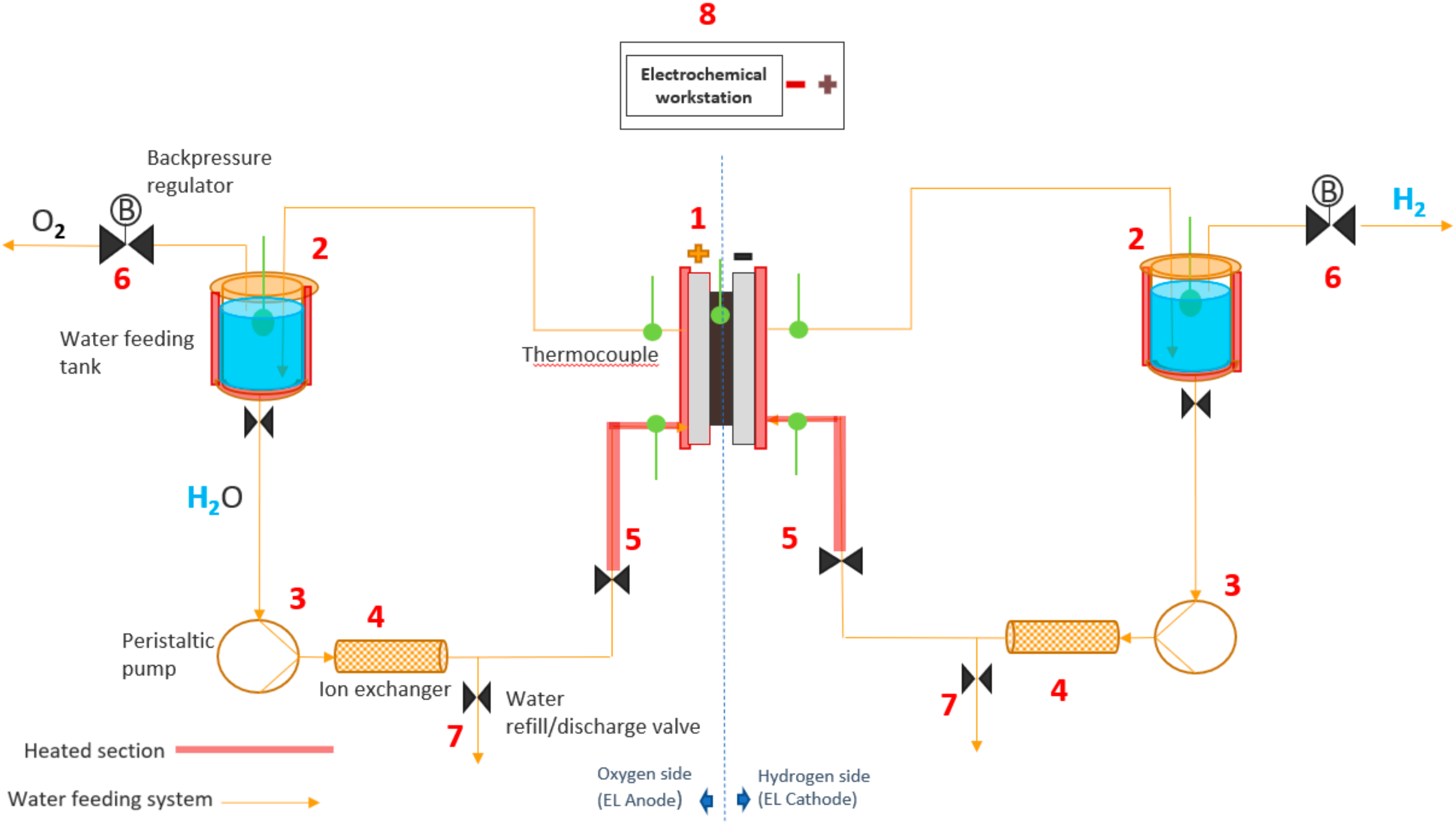
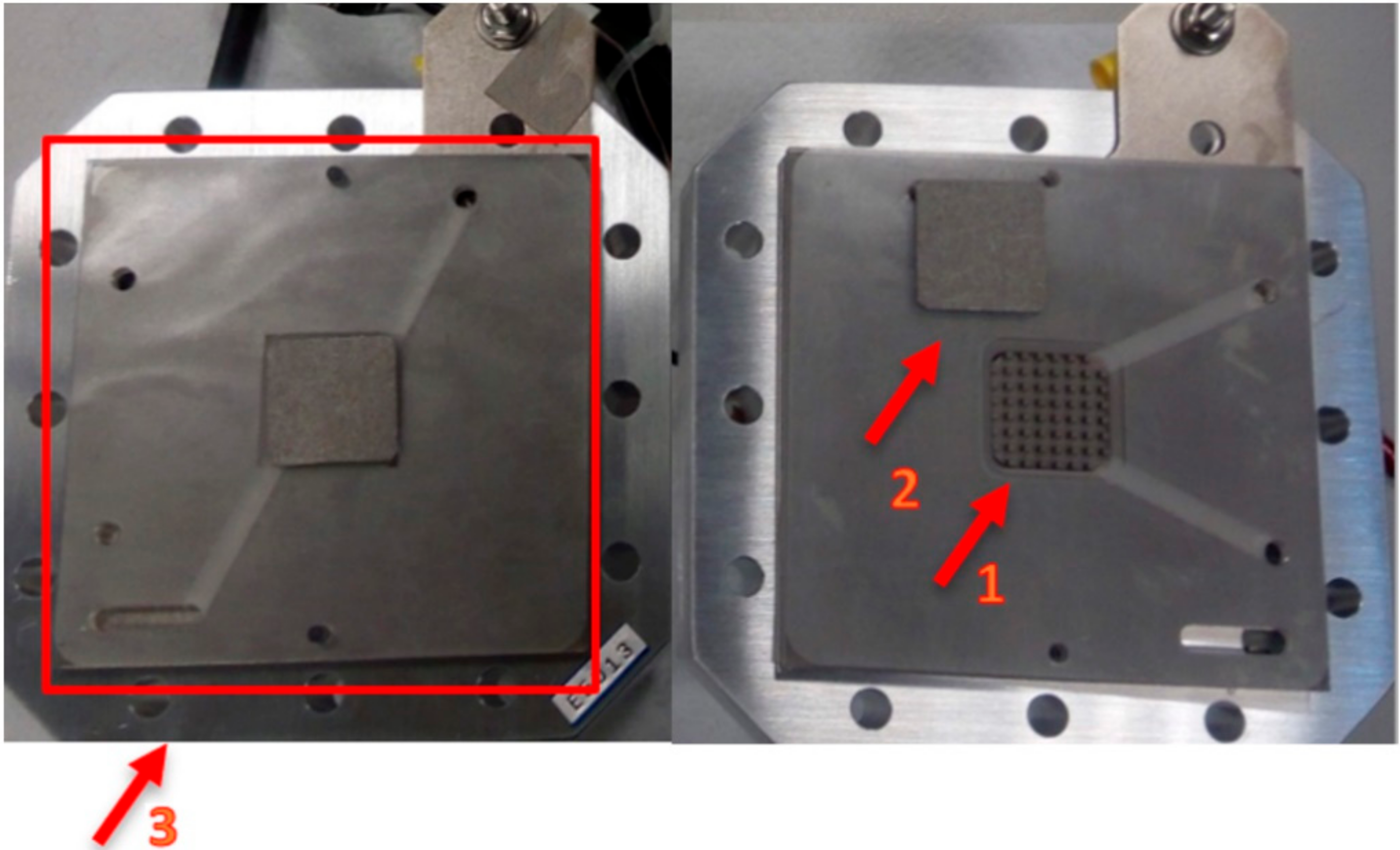
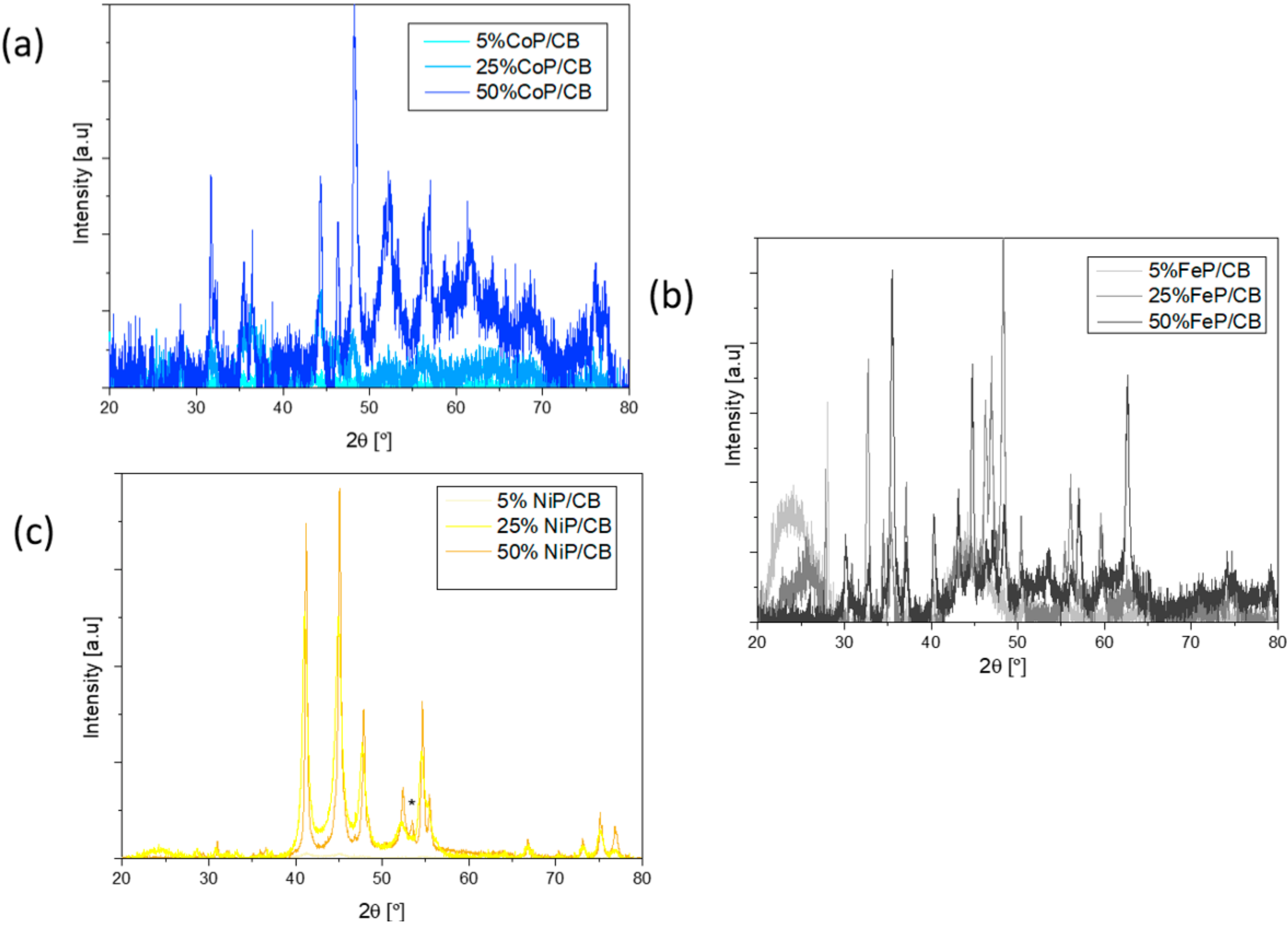
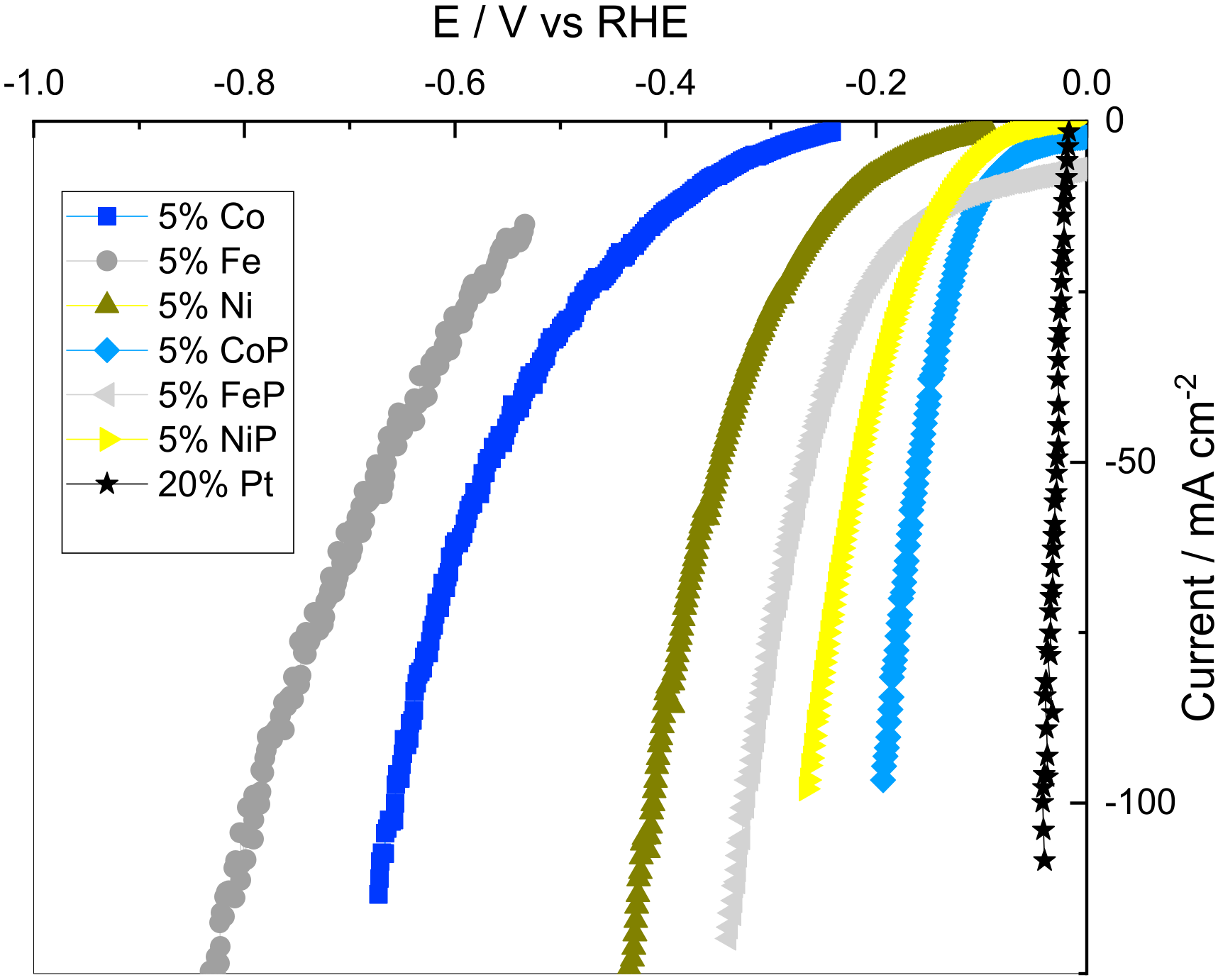
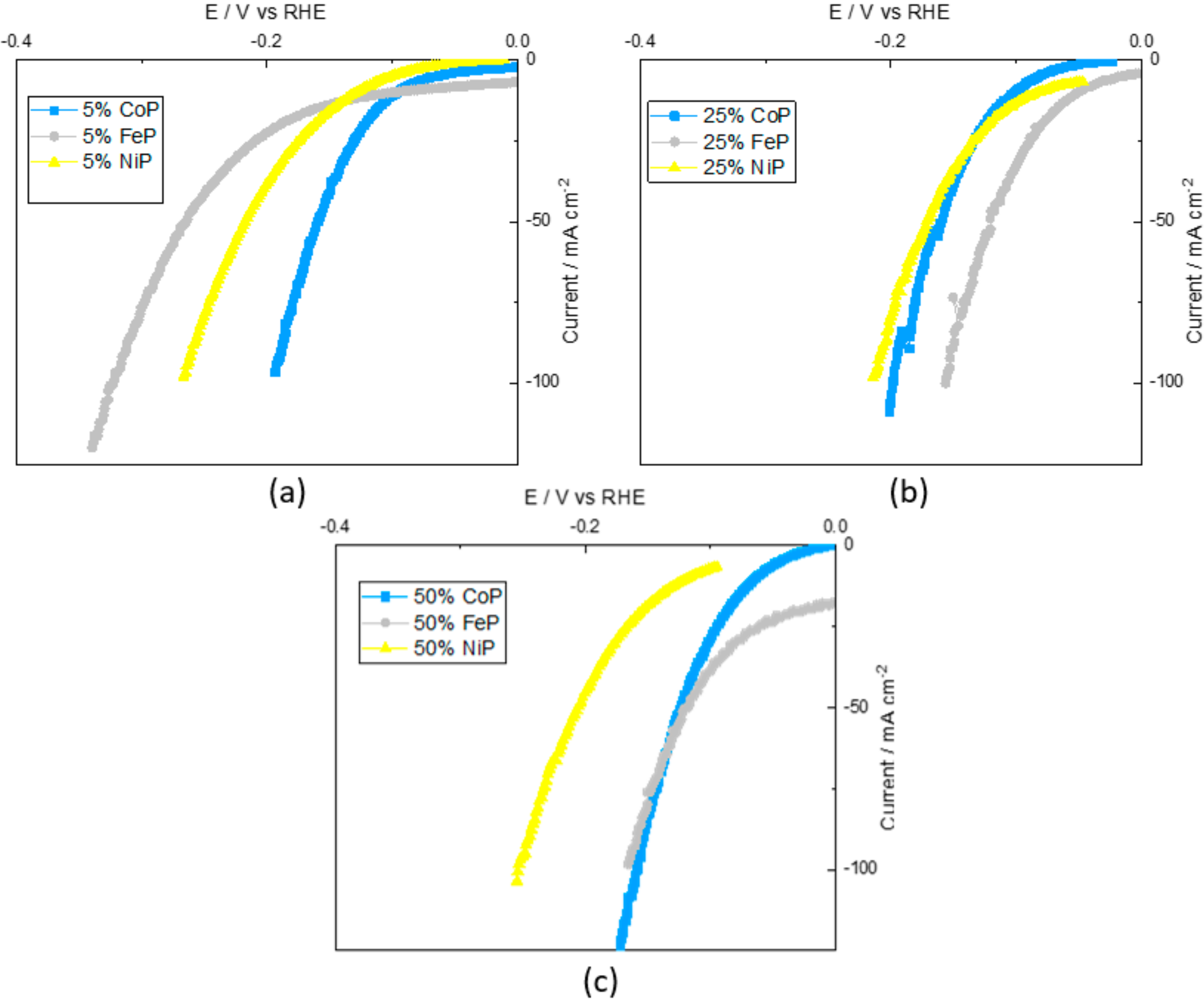
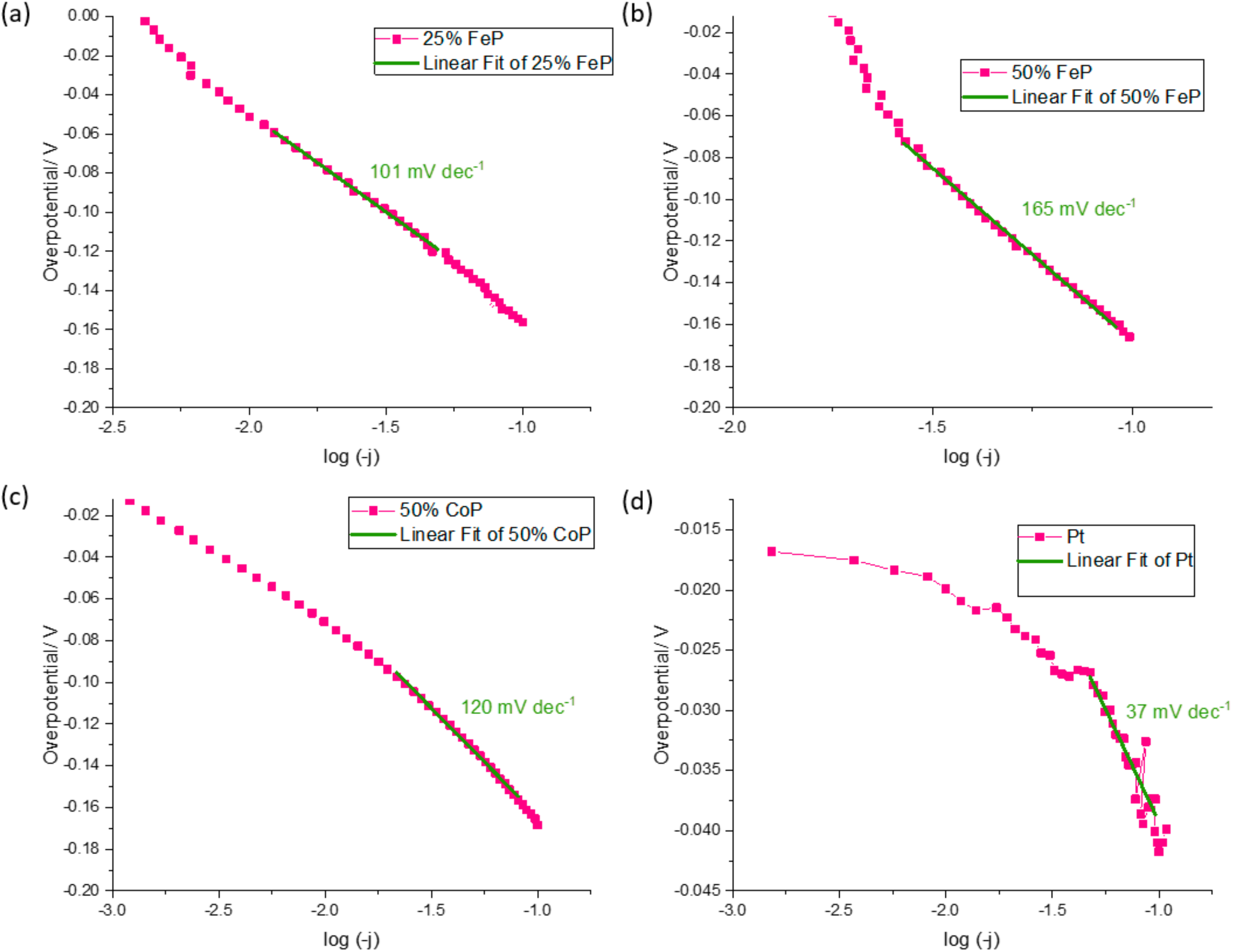
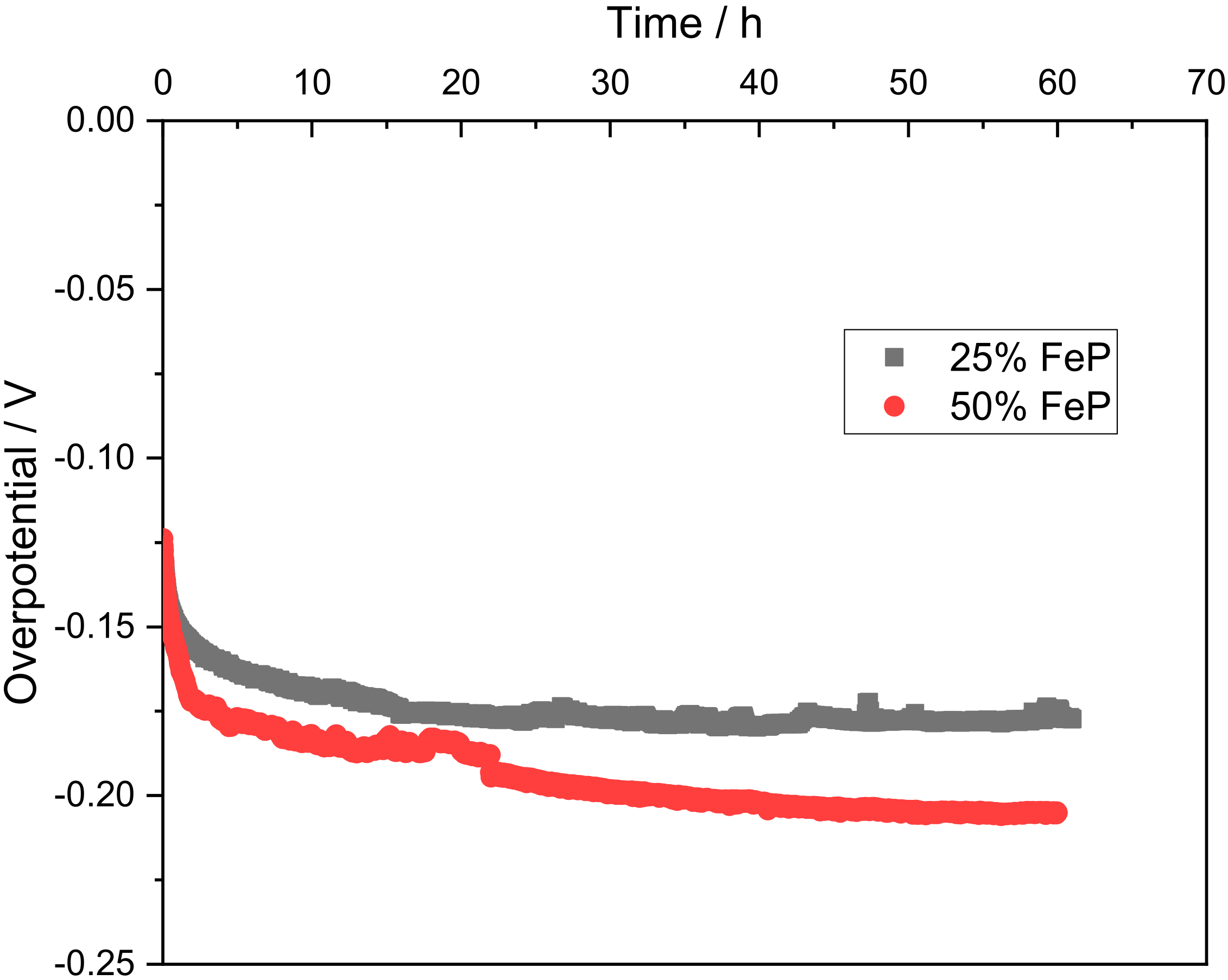
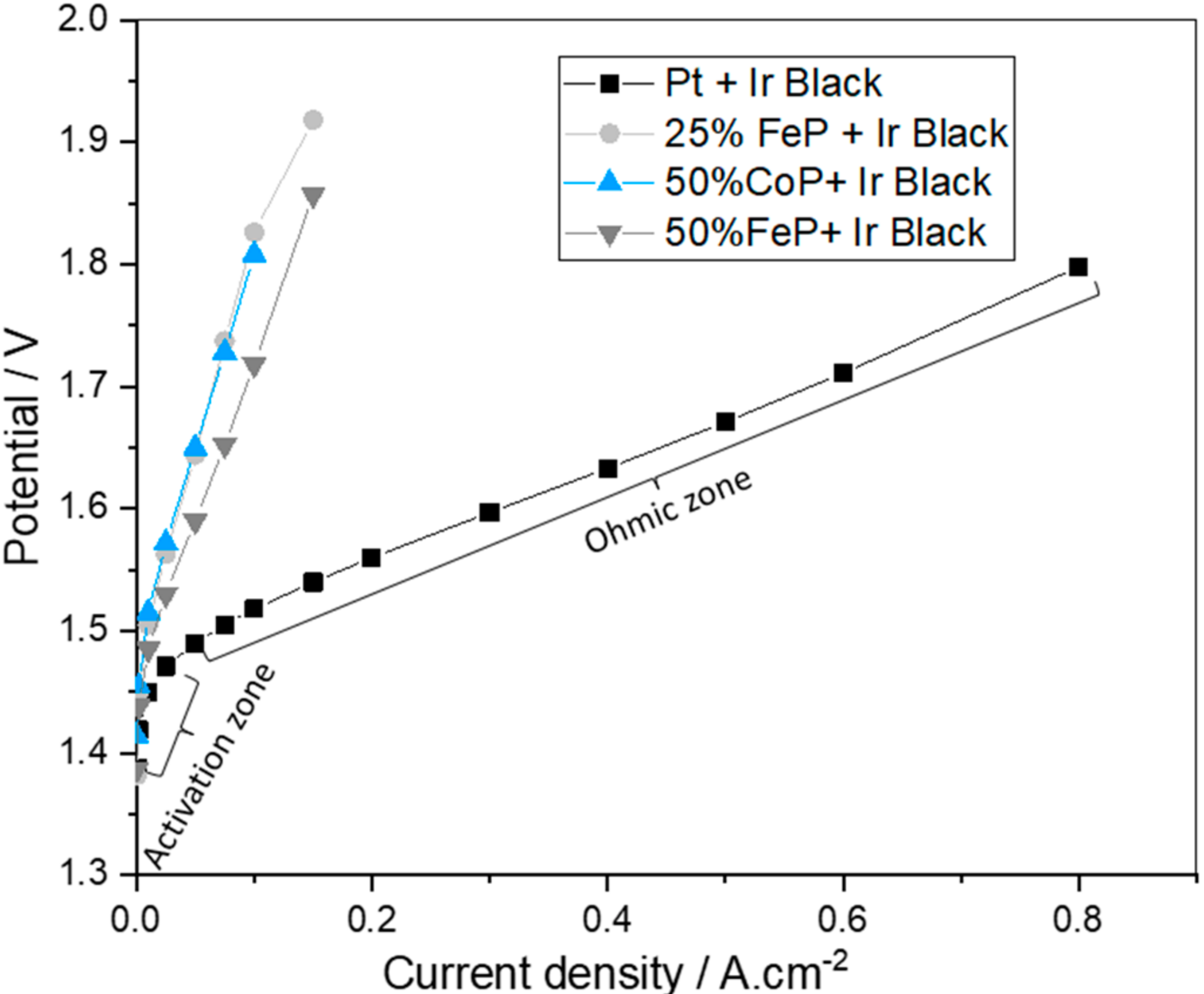

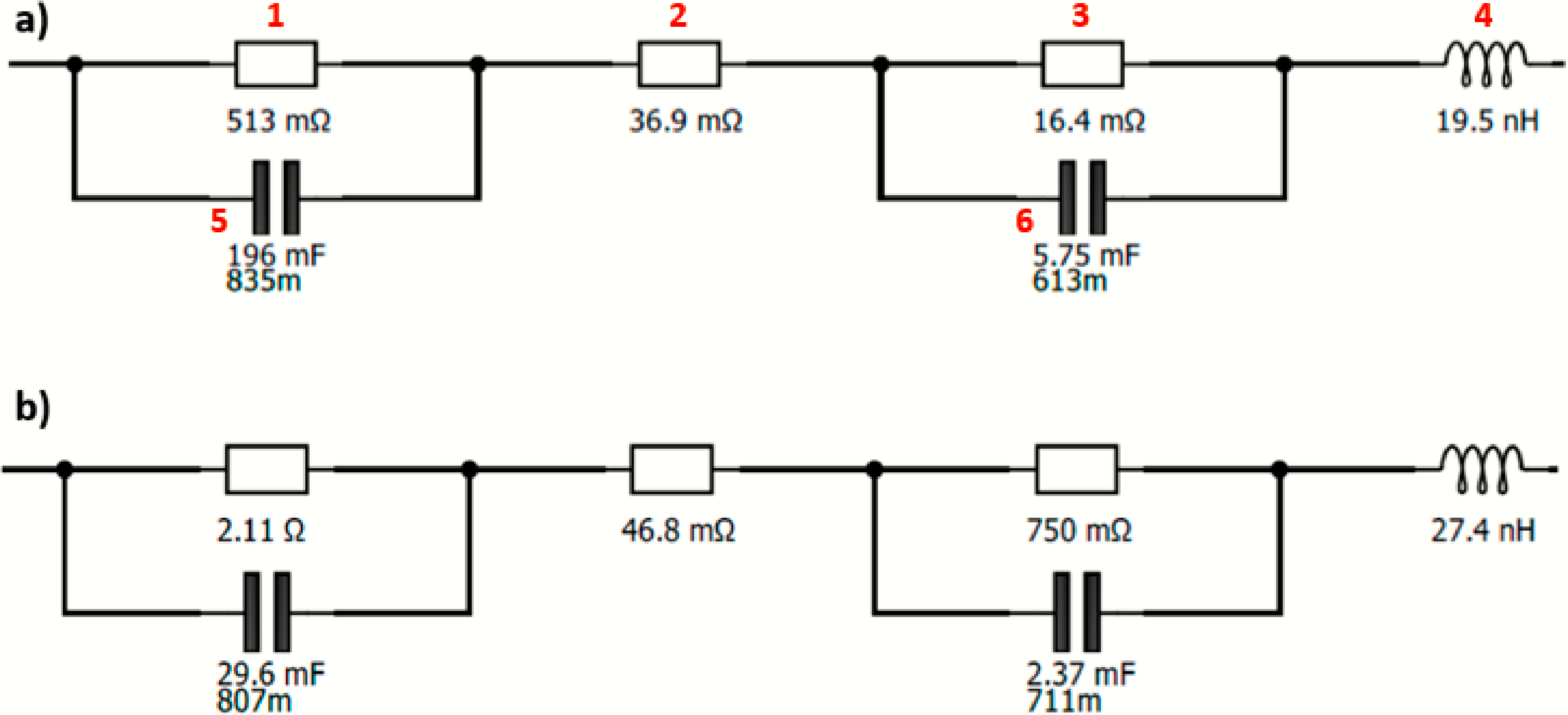
| Sample | Metal Content/% | SBET/m2 g−1 | SMeso/m2 g−1 | VMicro/cm3 g−1 | VP/Po = 0.95/cm 3g−1 |
|---|---|---|---|---|---|
| CB | - | 1241 | 370 | 0.40 | 2.52 |
| Fe/CB | 5 | 1209 | 385 | 0.34 | 1.88 |
| 25 | 701 | 327 | 0.17 | 0.99 | |
| 50 | 282 | 224 | 0.03 | 0.52 | |
| Co/CB | 5 | 1243 | 419 | 0.34 | 2.10 |
| 25 | 837 | 295 | 0.23 | 1.22 | |
| 50 | 267 | 211 | 0.02 | 0.42 | |
| Ni/CB | 5 | 1164 | 366 | 0.33 | 2.02 |
| 25 | 786 | 358 | 0.19 | 1.10 | |
| 50 | 333 | 281 | 0.02 | 0.50 |
| Sample | Metal Content/% | SBET/m2 g−1 | SMeso/m2 g−1 | VMicro/cm3 g−1 | VP/Po = 0.95/cm 3g−1 |
|---|---|---|---|---|---|
| FeP/CB | 5 | 924 | 322 | 0.25 | 1.52 |
| 25 | 415 | 239 | 0.07 | 0.68 | |
| 50 | 259 | 197 | 0.03 | 0.51 | |
| CoP/CB | 5 | 928 | 497 | 0.17 | 1.89 |
| 25 | 604 | 287 | 0.13 | 1.05 | |
| 50 | 89 | 79 | 0.004 | 0.21 | |
| NiP/CB | 5 | 1010 | 357 | 0.27 | 1.75 |
| 25 | 542 | 271 | 0.11 | 0.87 | |
| 50 | 208 | 168 | 0.02 | 0.37 |
| Metal Content/% | Sample | Moisture/% | Volatiles/% | Cfixed/% | Ash/% | Metal/% |
|---|---|---|---|---|---|---|
| 0 | CB | 0.4 | 8.8 | 88.5 | 2.7 | - |
| Co/CB | 0.5 | 14.6 | 76.0 | 9.5 | 6.8 | |
| 5 | Fe/CB | 0.4 | 15.8 | 75.0 | 9.3 | 6.6 |
| Ni/CB | 0.4 | 16.6 | 73.8 | 9.5 | 6.9 | |
| Co/CB | 0.4 | 27.9 | 37.9 | 34.2 | 31.5 | |
| 25 | Fe/CB | 0.3 | 33.2 | 31.3 | 35.4 | 32.8 |
| Ni/CB | 0.3 | 23.5 | 41.8 | 34.7 | 32.0 | |
| Co/CB | 0.2 | 18.8 | 12.4 | 68.8 | 66.1 | |
| 50 | Fe/CB | 0.1 | 27.9 | 10.5 | 61.6 | 58.9 |
| Ni/CB | 0.1 | 19.9 | 19.6 | 60.5 | 57.8 |
| Metal Content/% | Sample | Overpotential at 10 mA cm−2/mV | Overpotential at 50 mA cm−2/mV | Overpotential at 100 mA cm−2/mV | Tafel Slope/mV dec−1 |
|---|---|---|---|---|---|
| FeP/CB | −98.7 | −264.7 | −322.8 | 221 | |
| 5 | CoP/CB | −96.0 | −159.3 | −193.5 | 251 |
| NiP/CB | −128.3 | −217.3 | −266.5 | 150 | |
| FeP/CB | −51.0 | −120.7 | −156.0 | 101 | |
| 25 | CoP/CB | −101.4 | −159.5 | −198.3 | 85 |
| NiP/CB | −82.4 | −171.3 | −214.3 | 129 | |
| FeP/CB | - | −111.8 | −165.9 | 165 | |
| 50 | CoP/CB | −63.5 | −124.0 | −158.5 | 120 |
| NiP/CB | −118.0 | −206.0 | −254.0 | 125 | |
| 20 | Pt/CB | −19.9 | −27.9 | −41.0 | 37 |
| Potential/V | Membrane | Activation Resistance/Ω cm2 | Ohmic Resistance/Ω cm2 |
|---|---|---|---|
| 1.445 | 25%FeP/CB + Ir black | 18.55 | 0.25 |
| 50%FeP/CB + Ir black | 14.30 | 0.23 | |
| 50%CoP/CB+ Ir black | 34.14 | 0.23 | |
| Pt/CB + Ir black | 2.65 | 0.18 | |
| 1.465 | 25%FeP/CB + Ir black | 10.75 | 0.25 |
| 50%FeP/CB + Ir black | 8.68 | 0.23 | |
| 50%CoP/CB+ Ir black | 20.37 | 0.23 | |
| Pt/CB + Ir black | 1.10 | 0.18 |
Publisher’s Note: MDPI stays neutral with regard to jurisdictional claims in published maps and institutional affiliations. |
© 2022 by the authors. Licensee MDPI, Basel, Switzerland. This article is an open access article distributed under the terms and conditions of the Creative Commons Attribution (CC BY) license (https://creativecommons.org/licenses/by/4.0/).
Share and Cite
Brito, J.; Restivo, J.; Sousa, J.P.S.; Spera, N.C.M.; Falcão, D.S.; Rocha, A.; Pinto, A.M.F.R.; Pereira, M.F.R.; Soares, O.S.G.P. Implementation of Transition Metal Phosphides as Pt-Free Catalysts for PEM Water Electrolysis. Energies 2022, 15, 1821. https://doi.org/10.3390/en15051821
Brito J, Restivo J, Sousa JPS, Spera NCM, Falcão DS, Rocha A, Pinto AMFR, Pereira MFR, Soares OSGP. Implementation of Transition Metal Phosphides as Pt-Free Catalysts for PEM Water Electrolysis. Energies. 2022; 15(5):1821. https://doi.org/10.3390/en15051821
Chicago/Turabian StyleBrito, João, João Restivo, Juliana P. S. Sousa, Natalia C. M. Spera, D. S. Falcão, Amadeu Rocha, A. M. F. R. Pinto, Manuel Fernando R. Pereira, and Olívia Salomé G. P. Soares. 2022. "Implementation of Transition Metal Phosphides as Pt-Free Catalysts for PEM Water Electrolysis" Energies 15, no. 5: 1821. https://doi.org/10.3390/en15051821
APA StyleBrito, J., Restivo, J., Sousa, J. P. S., Spera, N. C. M., Falcão, D. S., Rocha, A., Pinto, A. M. F. R., Pereira, M. F. R., & Soares, O. S. G. P. (2022). Implementation of Transition Metal Phosphides as Pt-Free Catalysts for PEM Water Electrolysis. Energies, 15(5), 1821. https://doi.org/10.3390/en15051821











